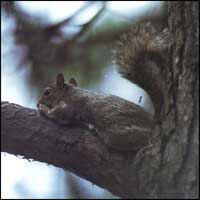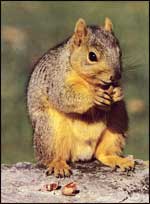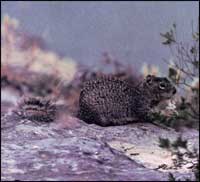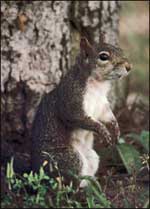Squirrels
Several species of squirrels make their home in Texas, but the one with the widest distribution is the fox squirrel. It prefers an open, parklike woods where large mature trees shade the forest floor and prevent the under-brush from flourishing, but it can adapt to a variety of forest habitats. It is most abundant in the eastern third of the state, and distribution in the wild is about one squirrel for every two or three acres. Since a fox squirrel ranges over an area of at least ten acres during any one season and may cover forty acres during a year's time, the territories of several often overlap. It is not uncommon for squirrels to share winter food supplies.

The gray squirrel is smaller and faster than the fox squirrel, and its agility and skittishness have given it a second name – cat squirrel.
Acorns are the most important fall and winter food for the fox squirrel. The nuts provide needed energy but are low in protein. Squirrels start eating hickory and other nuts in the dough stage while the nuts are still developing and continue eating them as they mature, burying them until the supply is gone. During the spring and summer the squirrels also eat insects, buds, green shoots, fruits, and seeds. The fruits provide energy and the insects and seeds provide the necessary protein. Mushrooms are another favorite food when available. The squirrels do most of their feeding in the early morning and late in the day. An adult fox squirrel weighs less than two pounds and averages about twenty inches long from the tip of its nose to the tip of its tail. The tail, which is usually less than half of its total length, is a cinnamon color mixed with black. Its body fur is a brownish-gray above with reddish-yellow underparts.
When an intruder comes near, the fox squirrel usually hides rather than runs. It will lie motionless or hide on the backside of the tree or a limb, peeping around to keep track of the intruder's location. If the intruder starts moving around the tree, the fox squirrel also shifts its position so a limb or the whole tree remains between itself and any possible danger.

Fox squirrels do most of their feeding in the early morning and late in the day.
Older females usually breed twice a year (January-February and again in May-June), but the younger females breed only once. Hollow trees are preferred den sites and nurseries, but if none is available the fox squirrel will build an outside nest from twigs and leaves cut from the tree. This ball-like nest structure will be twelve to twenty inches in diameter, surrounding an inner cavity six to eight inches across. Two to four helpless young are born six or seven weeks after breeding takes place. They are blind and nearly naked and develop slowly. Their eyes open at five weeks, but they do not climb out of the nest for at least seven or eight weeks. They do not get out of their nest tree until they are about ten weeks old. By the time they are three months old, they can fend for themselves. At ten or eleven months they reach sexual maturity, and the cycle can begin again.
About 90 percent of the squirrels in East Texas are another species, gray squirrels. They are similar to the fox squirrel in many ways, but in other ways they are quite different. The gray squirrel is more sociable than the fox squirrel, and it is more likely to be found in groups. It is smaller – about a pound in weight and only seventeen inches long from nose tip to tail tip. It is faster, and its agility and nervousness have given it a second name – cat squirrel. It is skittish and runs when frightened, leaping from limb to limb and branch to branch. It also checks on its surroundings more often than the fox squirrel does.
Like other squirrels, it has large eyes set on the sides of its head that allow it to see all around with little movement of its head. It can see above and below, an adaptation well suited for life in the trees where danger can come from the ground, through the air, or along a nearby limb. Squirrels also have a yellow filter in their eye lenses to help reduce glare and enhance contrast in low-light conditions to improve vision.
Choice areas for gray squirrels include the swamplike growths of trees and plants along streams and the dense bottomland forests with their nightmare of tangled second-growth hardwood, vines, and other plants. Few gray squirrels are found in the more open upland forests preferred by the fox squirrel. Like the fox squirrel, gray squirrels build outside leaf nests, usually with two openings, when hollow tree dens are not available. They breed throughout the year, but breeding peaks occur in July-September and December-February. The helpless young are born forty to forty-five days later and, like the fox squirrel's young, they are blind and naked. They remain in the nest for about six weeks and in family groups for a month or so after they begin foraging for themselves. By the time they are six months old, they are almost adult size, and they are ready to produce young of their own when they are a year old.
Fox and gray squirrels have always been popular game animals to test the skill of the woodsman. At one time they were so much a part of the rural menu that they were known as "limb chickens." Although they are not as widely eaten today, squirrel stew is still a favorite meal for many East Texans. Most claim the gray squirrel tastes better and is more tender than the fox squirrel.

Rugged areas such as cliffs, canyon walls, boulder piles, and highway fills are good habitat for the rock squirrel.
Another tree squirrel, but one that is not hunted, is the little flying squirrel. Although it is common in the eastern part of the state, it is nocturnal (active at night) and seldom seen during the day. Perhaps this is just as well since the flying squirrel is quite timid and, if cornered, may become paralyzed with fear and die of shock. Its name is a bit misleading since it cannot fly; however, it does glide. In fact, gliding is its main form of transportation, and it may cover as much as 150 feet during a single glide.
The flying squirrel's small three-ounce body is well designed for gliding through the air. It is only eight to ten inches long and its tail, which serves as a rudder to guide it in flight, is at least half of its total length. Its body is covered with about a hundred square inches of skin that forms wing-like side flaps that stretch between its "ankle" and "wrist" and give it some fifty square inches of airfoil surface. Before launching itself, it climbs to a high point in a tree, using its sharp claws and strong legs. Just before it leaps, it moves its body back and forth to determine the range, draws its feet together, coils into a ball, and then springs, spread-eagle, into the air. By varying the slack in the skin along its sides, it is able to turn and bank as it glides through the trees from its launch site.
Large eyes help it to see obstructions. Its fluffy, flattened tail is used as a brake to slow it down before it lands feet first on its target. As soon as it lands, it darts to the other side of the tree to avoid predators, such as an owl, cat, or raccoon, that might have been watching its flight. If danger threatens and the flying squirrel has to leap without making a flight plan, the landing may be less than perfect. If it lands in water, the flaps of skin so helpful in the air become a handicap. It cannot swim and probably will drown.
The flying squirrel is always on the move when awake and burns energy at a terrific rate. As they are for most squirrels, nuts are an important part of its diet, and the flying squirrel stores them in a tree cache. It also eats berries, tender buds, grasshoppers, moths, bugs, acorn grubs, and other such items. It eats very little green vegetation.
Since this squirrel is so small, it can easily use a woodpecker's nest as a den site. However, if no cavity is available, it will build a nest of leaves and twigs. In those areas where Spanish moss is available, a ball of it may contain and conceal such a nest. The young are born from March to May in litters of three to six, about forty days after breeding takes place. They are about the size of a quarter at birth and weigh less than half an ounce. Flight training begins when they are a few weeks old, and in a short time they are gliding through the trees. The flying squirrel matures slowly and will not be ready to breed for more than a year.

The location of the gray squirrel's large eyes allows it to see all around with little movement of its head.
For a look at the last squirrel being featured, we must move out of the East Texas tree tops and down to the ground in the Hill Country and West Texas, where the rock squirrel lives. Biologists tell us there are three subspecies of rock squirrels, which can be distinguished mainly by color and location. The Hill Country rock squirrels are a beautiful black color on the head and shoulders, fading to a salt-and-pepper shade on the hind quarters. The West Texas species is a lighter gray or beige, and the Big Bend species is dark over its entire body. Rock squirrels are almost always found in rocky areas, such as cliffs, canyon walls, boulder piles, highway fills, and other rugged terrain. Observers have seen them climb what appear to be smooth walls with speed and agility. Closer inspection of these walls reveals cracks and irregularities that provide footholds for the squirrels. Although considered a ground-dweller, the rock squirrel can climb trees almost as well as a tree squirrel. It is not unusual to see one sitting in the top of a juniper feeding on the berries or in mesquite trees eating the buds or beans.
Occasionally a rock squirrel will make its den in a tree hollow, but most of the time it lives in an under-ground burrow. The entrance is usually located under a rock or in a crevice to conceal it from predators. Hill Country rock squirrels have found that the rock fences and stone walls built by early settlers in that area meet their living requirements perfectly. These walls serve as lookout posts, elevated runways, and covers for burrows. Rocky cliff sides also offer protection from enemies, which include hawks and other birds of prey, foxes, raccoons, bobcats, coyotes, dogs, snakes, and humans. They provide ready-made den sites and crevices for storing nuts, seeds, and berries for winter.
The larger adults may spend a couple of months during the winter sleeping in their burrows. Since they occasionally are seen above ground on mild winter days, either they do not go into full hibernation in Texas or their periods of hibernation are interrupted. In preparation for their time under ground, they build up a layer of body fat and store food in the burrows or bury it close by. The story is told of a farmer who had two rock squirrels living under his tool shed. In the fall he stored forty pumpkins, weighing about ten pounds each, in a barn nearby. A month later when he went to get one of the pumpkins, he discovered that the two rock squirrels had managed to hollow out every single one of them. The squirrels had eaten the pumpkin meat and stored the seeds beneath the floor of the tool shed to eat later.
Young squirrels enter their winter burrows later than the adults, if at all. Many remain active throughout the winter because they are too small to build up enough fat to supply the energy needed for a long sleeping period. In late January and early February the adults begin emerging from their burrows for an hour or so each day to sun and feed. Rock squirrels eat a variety of plants, such as small herbs, flowers, leaves, seeds, nuts, and fruit, as well as grasshoppers and other insects. Since they also are fond of flesh, they may catch and eat small wild turkeys and other birds.
Rock squirrels can carry off a large amount of food by packing it in their external cheek pouches. Studies have shown that these cheek pouches may contain as many as eight medium pecans or eleven acorns. A typical feeding behavior is for the squirrel to pack its cheek pouches full of food and then sit on a high rock and eat what it has gathered. One way to tell if a rock squirrel is in an area is to look for a pile of fruit seeds or nut shells on the largest, highest rock around.
In March the breeding season begins, and competition for the females is fierce. The dominant male rock squirrel tries to prevent other males from entering his territory, where they might breed with the resident females. Scent glands on the cheeks produce a musky-smelling oil that is rubbed on rocks, logs, and fence posts to mark the squirrel's territory. Injuries often occur during these territorial fights, and although most of them heal quickly, occasionally a squirrel dies of either the injuries or infections that may result. About thirty days after breeding, four or five young are born in the underground burrow. As with other squirrels, the females have the sole responsibility for raising the young. The young do not appear above ground until early summer, when they are about eight weeks old. They have bright white eye rings and bushy silver tails.
The young stay close together and seldom venture more than a yard or so from the burrow entrance for the first week. While they are out of the burrow, the mother serves as look-out, and at the first sound of her alarm chirp, the young dive under the rock and into the burrow. To move slowly or ignore her warning could mean death. In addition to the alarm chirp, rock squirrels communicate vocally with growls, chuffs, barks, chirps, and variations or combinations of all four. By the time they are three months old, the young rock squirrels are ready to leave home and find their own burrows. When they reach maturity, the cycle of these interesting ground squirrels will begin again.
Now that we have taken a brief look into the different lives of these Texas squirrels, we can appreciate the special niche each one fills.
Ilo
Hiller
1990 – Squirrels: Introducing Mammals to Young
Naturalists. The Louise
Lindsey Merrick Texas Environment
Series, No. 10, pp. 53-61.
Texas A&M University
Press, College Station.